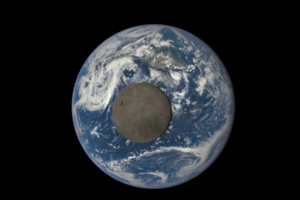Astounding NASA image captures the moon's far side
Images of the other side of the moon, released by NASA on Wednesday, would be impossible to take from Earth.

Screen shot of animation that features actual satellite images of the far side of the moon, illuminated by the sun, as it crosses between the DSCOVR spacecraft's Earth Polychromatic Imaging Camera (EPIC) and telescope, and the Earth - one million miles away.
NASA/NOAA
NASA just released images of the moon that would be impossible to capture from Earth. The series, which the space agency turned into an animation, shows the fully illuminated far side of the moon.
“It is surprising how much brighter Earth is than the moon," said Adam Szabo, DSCOVR project scientist at NASA’s Goddard Space Flight Center in a statement. "Our planet is a truly brilliant object in dark space compared to the lunar surface.”
The images were captured 1 million miles from Earth by NASA’s Earth Polychromatic Imaging Camera (EPIC), a camera and telescope aboard the DSCOVR satellite orbiting our planet. DSCOVR's primary mission is real-time solar wind monitoring for the National Oceanic and Atmospheric Administration (NOAA), according to NASA. Without its timely warnings, space weather events like geomagnetic storms caused by changes in solar wind run the risk of disrupting nearly every major public infrastructure system, including power grids, telecommunications, aviation, and GPS, according to NASA. Its positioning between the Sun and Earth can warn scientists 15 minutes to an hour ahead of a solar flare's ability to pose a threat.
EPIC keeps a constant view of the Earth as it rotates, providing scientific observations of ozone, vegetation, cloud height and aerosols in the atmosphere. Once EPIC begins regular observations next month, the camera will provide a series of images of Earth allowing study of daily variations over the entire globe. About twice a year the camera will capture the moon and Earth together as the orbit of DSCOVR crosses the orbital plane of the moon, according to NASA.
A Soviet spacecraft, the Luna 3, was the first to return images of the far side of the moon in 1959. Since then, several NASA missions have captured images of the moon's rarely seen side. The crew aboard NASA's Apollo 8 were the first humans to see that side of the moon in 1968. The moon always faces an earthbound observer on the same side because the moon is tidally locked to Earth, which means the time it takes to orbit once is the same as the time it takes to rotate around its axis, according to NASA.
In May 2008 NASA’s Deep Impact spacecraft captured a similar view of Earth and the moon from a distance of 31 million miles away.
This photo series of the moon's far side were just test shots. EPIC will begin regular observations next month, and NASA announced a public website which will post daily color images of Earth. These images, showing different views of the planet as it rotates through the day, will be available 12 to 36 hours after they are captured by EPIC.

